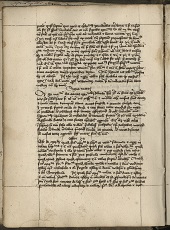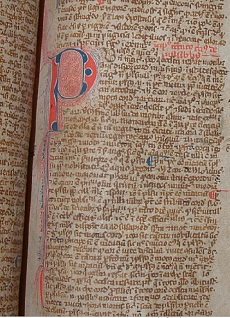 Clear markings of page layout, from Medical MiscellanyWhereas monks produced manuscripts almost exclusively for most of the medieval period, beginning in the thirteenth century, the process became more secularized.
Clear markings of page layout, from Medical MiscellanyWhereas monks produced manuscripts almost exclusively for most of the medieval period, beginning in the thirteenth century, the process became more secularized. Anglicana bookhand, Petrus Peregrinus manuscriptThe growing industry of book production now split the work between several types of specially trained craftsmen: scribes, rubricators, and illuminators. Scribes were responsible for ruling the parchment or paper, page layout, and copying the text. Trained in the handwriting styles of the day, their scripts are helpful in determining the date and location of book production. For example, Petrus Peregrinus' Tractatus de Magnete was written in an Anglicana bookhand, which was common in England in the thirteenth through fifteenth centuries.
Anglicana bookhand, Petrus Peregrinus manuscriptThe growing industry of book production now split the work between several types of specially trained craftsmen: scribes, rubricators, and illuminators. Scribes were responsible for ruling the parchment or paper, page layout, and copying the text. Trained in the handwriting styles of the day, their scripts are helpful in determining the date and location of book production. For example, Petrus Peregrinus' Tractatus de Magnete was written in an Anglicana bookhand, which was common in England in the thirteenth through fifteenth centuries.
 Pen-flourished initial from the Bernard of Gordon manuscriptIn laying out their manuscripts, scribes left empty spaces for rubricators and illuminators to fill in with decoration. Rubricators were responsible for the colored initials and titles that initiate separate tracts or chapters. Usually done in red (but also seen in blue or green), the word rubrication comes from the Latin word for red, rubrico. Styles of rubrication also help date texts. For example, the red and blue pen-flourished initials extending down the margins, as seen in the manuscript of Bernard of Gordon, were typical of Gothic manuscripts of the thirteenth and fourteenth centuries (Clemens and Graham, pp. 26-27).
Pen-flourished initial from the Bernard of Gordon manuscriptIn laying out their manuscripts, scribes left empty spaces for rubricators and illuminators to fill in with decoration. Rubricators were responsible for the colored initials and titles that initiate separate tracts or chapters. Usually done in red (but also seen in blue or green), the word rubrication comes from the Latin word for red, rubrico. Styles of rubrication also help date texts. For example, the red and blue pen-flourished initials extending down the margins, as seen in the manuscript of Bernard of Gordon, were typical of Gothic manuscripts of the thirteenth and fourteenth centuries (Clemens and Graham, pp. 26-27).
 Space for illustrations in the Arnold of Villanova manuscriptLarger spaces within the text were left for illustrations to be done by an illuminator or miniaturist. Proof that manuscripts were produced this way is seen in examples such as the Reynolds-Finley Library's manuscript of Arnold of Villanova where empty spaces still remain after pages of frequent illumination.
Space for illustrations in the Arnold of Villanova manuscriptLarger spaces within the text were left for illustrations to be done by an illuminator or miniaturist. Proof that manuscripts were produced this way is seen in examples such as the Reynolds-Finley Library's manuscript of Arnold of Villanova where empty spaces still remain after pages of frequent illumination.
